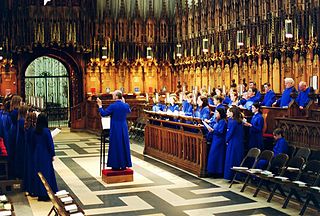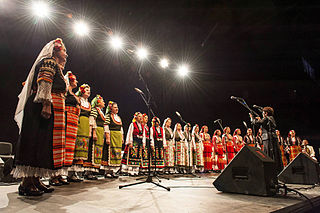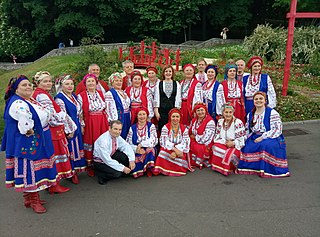
Polyphony is a type of musical texture consisting of two or more simultaneous lines of independent melody, as opposed to a musical texture with just one voice (monophony) or a texture with one dominant melodic voice accompanied by chords (homophony).

A song is a musical composition performed by the human voice. The voice often carries the melody using patterns of sound and silence. Songs have a structure to them, such as the common ABA form, and are usually made of sections that are repeated or performed with variation later. A song without instruments is said to be a cappella.

A choir is a musical ensemble of singers. Choral music, in turn, is the music written specifically for such an ensemble to perform or in other words is the music performed by the ensemble. Choirs may perform music from the classical music repertoire, which spans from the medieval era to the present, or popular music repertoire. Most choirs are led by a conductor, who leads the performances with arm, hand, and facial gestures.

Overtone singing, also known as overtone chanting, harmonic singing, polyphonic overtone singing, or diphonic singing, is a set of singing techniques in which the vocalist manipulates the resonances of the vocal tract to arouse the perception of additional separate notes beyond the fundamental frequency that is being produced.

A number of ancient civilizations, including the Thracians, ancient Greeks, Scythians, Celts, ancient Romans, Goths, Slavs, Varangians and the Bulgars have left their mark on the culture, history and heritage of Bulgaria. Due to this great variety of influences, Bulgaria has adopted many unusual traditions. Thracian artifacts include numerous temples, tombs, golden treasures and ancient rites and rituals, while the Bulgars have left traces of their heritage in statehood, early architecture, music and dances. Thracian rituals such as the Tryphon Zarezan which is dedicated to Saint Tryphon of Campsada, Kukeri and Martenitsa are to this day kept alive in the modern Bulgarian culture. The oldest treasure of worked gold in the world, dating back to the 5th millennium BC, comes from the site of the Varna Necropolis.
Ukrainian music covers diverse and multiple component elements of the music that is found in the Western and Eastern musical civilization. It also has a very strong indigenous Slavic and Christian uniqueness whose elements were used among the areas that surround modern Ukraine.

The music of Albania is associated with the country of Albania and Albanian communities. Music has a long tradition in the country and is known for its regional diversity, from the Ghegs in the North to the Tosks in the South. It is an integral part of the national identity, strongly influenced by the country's long and turbulent history, which forced Albanians to protect their culture from their overlords by living in rural and remote mountains.

The music of Bulgaria refers to all forms of music associated with the country of Bulgaria, including classical, folk, popular music, and other forms.
Georgia has rich and still vibrant traditional music, primarily known for arguably the earliest polyphonic tradition of the Christian world. Situated on the border of Europe and Asia, Georgia is also the home of a variety of urban singing styles with a mixture of native polyphony, Middle Eastern monophony and late European harmonic languages. Georgian performers are well represented in the world's leading opera troupes and concert stages.

Soghomon Soghomonian, ordained and commonly known as Komitas, was an Ottoman-Armenian priest, musicologist, composer, arranger, singer, and choirmaster, who is considered the founder of the Armenian national school of music. He is recognized as one of the pioneers of ethnomusicology.
Russian folk music specifically deals with the folk music traditions of the ethnic Russian people.

The Bulgarian State Television Female Vocal Choir is an internationally renowned musical ensemble that performs modern arrangements of traditional Bulgarian folk melodies. It is most recognized for its contribution to Marcel Cellier's Le Mystère des Voix Bulgares project. First created in 1952 as the Ensemble for Folk Songs of the Bulgarian Radio by Georgi Boyadjiev, the choir is now under the direction of Dora Hristova. The choir was granted the name Le Mystère des Voix Bulgares by Marcel Cellier in 1997, in recognition of the fact that it had contributed most of the songs on the original compilations.

A show choir is a musical ensemble that combines choral singing with choreographed dance, often with an overarching theme. It is most relevant in the Midwestern United States and was popularized by the American television show Glee.

Ukrainian folk music includes a number of varieties of traditional, folkloric, folk-inspired popular music, and folk-inspired European classical music traditions.

Boris Papandopulo was a Croatian composer and conductor of Greek and Russian Jewish descent. He was the son of Greek nobleman Konstantin Papandopulo and Croatian opera singer Maja Strozzi-Pečić and one of the most distinctive Croatian musicians of the 20th century. Papandopulo also worked as music writer, journalist, reviewer, pianist and piano accompanist; however, he achieved the peaks of his career in music as a composer. His composing oeuvre is imposing : with great success he created instrumental, vocal and instrumental, stage music and film music. In all these kinds and genres he left a string of anthology-piece compositions of great artistic value.

Tenore di Bitti "Mialinu Pira" is an Italian ensemble formed in 1995, specialized in the Sardinian cantu a tenore. The Cantu a tenore is a style of polyphonic folk singing characteristic of the Barbagia region of the island, even though some other Sardinian sub-regions bear examples of such tradition. The cantu a tenore was proclaimed by the UNESCO "Masterpieces of the Oral and Intangible Heritage" in 2005.

Iso-Polyphony is a traditional part of Albanian folk music and, as such, is included in UNESCO's intangible cultural heritage list.

Bistritsa Babi are an elderly/multi-generational women's choir carrying on the traditional dances and polyphonic singing of the Shopluk region of Bulgaria. Founded in 1939, the group won the European Folk Art Award in 1978, and it was declared a Masterpiece of the Intangible Heritage of Humanity in 2005. Performing three-part polyphony with features "retained from the pre-Christian times," the group has toured Europe and the US. They are known for their use of Shopluk polyphony, costuming, dancing in a ring (horo), and performing the lazarouvane. In 2005 they were included in UNESCO List of Intangible Cultural Heritage elements in Eastern Europe.
Anzor Erkomaishvili was a Georgian singer, composer, and folk music researcher. He is known for his long-standing work as musical director of the folk choir Rustavi Ensemble since 1968 and efforts for preserving the folk singing heritage of Georgia.














